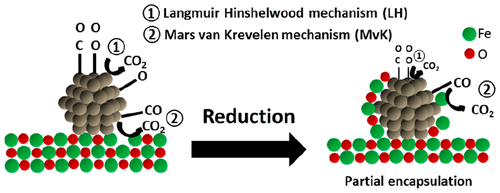当前位置:
X-MOL 学术
›
ACS Catal.
›
论文详情
Our official English website, www.x-mol.net, welcomes your
feedback! (Note: you will need to create a separate account there.)
Effects of Particle Size on Strong Metal–Support Interactions Using Colloidal “Surfactant-Free” Pt Nanoparticles Supported on Fe3O4
ACS Catalysis ( IF 11.3 ) Pub Date : 2020-03-18 , DOI: 10.1021/acscatal.9b04367 Sarah Neumann 1, 2 , Hans Hannes Doebler 1, 2 , Simona Keil 1, 2 , Alexandra J. Erdt 3 , Christian Gutsche 3 , Holger Borchert 3 , Joanna Kolny-Olesiak 3 , Jürgen Parisi 3 , Marcus Bäumer 1, 2 , Sebastian Kunz 1, 2, 4
ACS Catalysis ( IF 11.3 ) Pub Date : 2020-03-18 , DOI: 10.1021/acscatal.9b04367 Sarah Neumann 1, 2 , Hans Hannes Doebler 1, 2 , Simona Keil 1, 2 , Alexandra J. Erdt 3 , Christian Gutsche 3 , Holger Borchert 3 , Joanna Kolny-Olesiak 3 , Jürgen Parisi 3 , Marcus Bäumer 1, 2 , Sebastian Kunz 1, 2, 4
Affiliation

|
Colloidal “surfactant-free” Pt nanoparticles (NPs) within the size range 1–4 nm supported on Fe3O4 were synthesized and applied as model systems to systematically study the role of size effects for strong metal–support interactions (SMSIs) with CO oxidation as a model reaction. Kinetic studies, isotopic labeling experiments with 18O2, and diffuse reflectance infrared Fourier transform spectroscopy (DRIFTS) were applied to explore the reaction mechanism and the surface of the catalyst before and after reductive pretreatments. It was found that pure iron oxide was catalytically active in CO oxidation, and experimental evidence for a Mars van Krevelen mechanism between CO and lattice O was found. The turnover frequencies (TOFs) for small Pt NPs (≤3 nm) supported on iron oxide and normalized to the number of Pt atoms located at the periphery of the Pt–support interface were similar under reaction conditions, indicating that the reaction mainly proceeds at the interface. However, with increasing particle size, the contribution of a Langmuir–Hinshelwood mechanism of chemisorbed CO and O2 in addition to the Mars van Krevelen mechanism increases. After reductive pretreatment, the activity of the catalyst decreased significantly, which could be related to partial encapsulation of the monometallic Pt NPs with FeOx. To study whether also on the nanoscale an interaction between Pt and iron oxide similar to the beneficial or detrimental SMSI effect observed for the Pt particles supported on iron oxide can also be achieved, bimetallic Fe–Pt NPs of a mean size of 3–4 nm were deposited on inert Al2O3. It could be shown that surface segregation of Fe and formation of FeOx after reduction and exposure to oxygen took place. As a result, the activity of bimetallic NPs decreased due to loss of active Pt surface, revealing an effect similar to the detrimental SMSI detected for Pt NPs on FeOx support after reductive pretreatment.
中文翻译:

Fe 3 O 4负载胶体“无表面活性剂” Pt纳米颗粒对强金属-支撑相互作用的影响
合成了在Fe 3 O 4上负载的大小为1-4 nm的胶体“无表面活性剂”的Pt纳米颗粒(NPs),并将其用作模型系统,系统地研究了尺寸效应对强金属-载体相互作用(SMSI)的影响。以CO氧化为模型反应。动力学研究,用18 O 2进行同位素标记实验,漫反射红外傅里叶变换光谱法(DRIFTS)用于探索还原性预处理前后的反应机理和催化剂表面。发现纯氧化铁在CO氧化中具有催化活性,并且发现了CO与晶格O之间的Mars van Krevelen机理的实验证据。在反应条件下,氧化铁上负载的小Pt NP(≤3nm)的周转频率(TOFs)标准化为Pt-support界面外围的Pt原子数,表明反应主要在接口。但是,随着粒径的增加,化学吸附的CO和O 2的Langmuir–Hinshelwood机理的贡献除了火星的范·克雷维伦机制外。还原性预处理后,催化剂的活性显着下降,这可能与单金属Pt NPs与FeO x的部分包封有关。为了研究是否还在纳米级上实现了Pt和氧化铁之间的相互作用,类似于在氧化铁上负载的Pt颗粒所观察到的有益或有害的SMSI效应,平均尺寸为3-4 nm的双金属Fe–Pt NP沉积在惰性Al 2 O 3上。可以证明Fe的表面偏析和FeO x的形成还原后暴露于氧气。结果,双金属NP的活性由于活性Pt表面的损失而降低,显示出类似于还原性预处理后在FeO x载体上检测到的Pt NPs的有害SMSI的效果。
更新日期:2020-03-19
中文翻译:

Fe 3 O 4负载胶体“无表面活性剂” Pt纳米颗粒对强金属-支撑相互作用的影响
合成了在Fe 3 O 4上负载的大小为1-4 nm的胶体“无表面活性剂”的Pt纳米颗粒(NPs),并将其用作模型系统,系统地研究了尺寸效应对强金属-载体相互作用(SMSI)的影响。以CO氧化为模型反应。动力学研究,用18 O 2进行同位素标记实验,漫反射红外傅里叶变换光谱法(DRIFTS)用于探索还原性预处理前后的反应机理和催化剂表面。发现纯氧化铁在CO氧化中具有催化活性,并且发现了CO与晶格O之间的Mars van Krevelen机理的实验证据。在反应条件下,氧化铁上负载的小Pt NP(≤3nm)的周转频率(TOFs)标准化为Pt-support界面外围的Pt原子数,表明反应主要在接口。但是,随着粒径的增加,化学吸附的CO和O 2的Langmuir–Hinshelwood机理的贡献除了火星的范·克雷维伦机制外。还原性预处理后,催化剂的活性显着下降,这可能与单金属Pt NPs与FeO x的部分包封有关。为了研究是否还在纳米级上实现了Pt和氧化铁之间的相互作用,类似于在氧化铁上负载的Pt颗粒所观察到的有益或有害的SMSI效应,平均尺寸为3-4 nm的双金属Fe–Pt NP沉积在惰性Al 2 O 3上。可以证明Fe的表面偏析和FeO x的形成还原后暴露于氧气。结果,双金属NP的活性由于活性Pt表面的损失而降低,显示出类似于还原性预处理后在FeO x载体上检测到的Pt NPs的有害SMSI的效果。











































 京公网安备 11010802027423号
京公网安备 11010802027423号